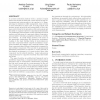Free Online Productivity Tools
i2Speak
i2Symbol
i2OCR
iTex2Img
iWeb2Print
iWeb2Shot
i2Type
iPdf2Split
iPdf2Merge
i2Bopomofo
i2Arabic
i2Style
i2Image
i2PDF
iLatex2Rtf
Sci2ools
CF
2004
ACM
2004
ACM
An architectural framework and a middleware for cooperating smart components
In a future networked physical world, a myriad of smart sensors and actuators assess and control aspects of their environments and autonomously act in response to it. Examples range in telematics, traffic management, team robotics or home automation to name a few. To a large extent, such systems operate proactively and independently of direct human control driven by the perception of the environment and the ability to organize respective computations dynamically. The challenging characteristics of these applications include sentience and autonomy of components, issues of responsiveness and safety criticality, geographical dispersion, mobility and evolution. A crucial design decision is the choice of opriate abstractions and interaction mechanisms. Looking to the basic building blocks of such systems we may find components which comprise mechanical components, hardware and software and a network interface, thus these components have different characteristics compared to pure software...
| Added | 30 Jun 2010 |
| Updated | 30 Jun 2010 |
| Type | Conference |
| Year | 2004 |
| Where | CF |
| Authors | Antonio Casimiro, Jörg Kaiser, Paulo Veríssimo |
Comments (0)

